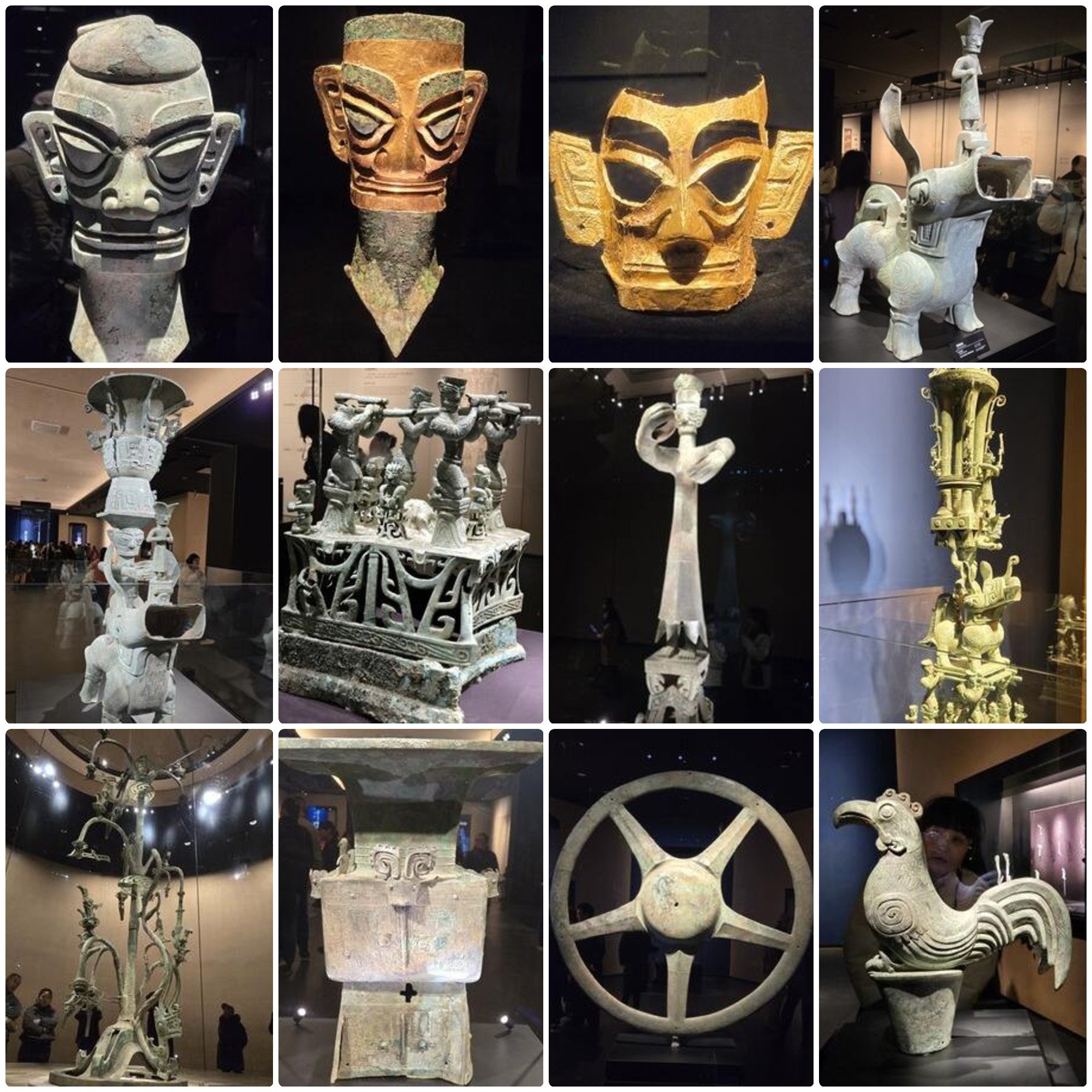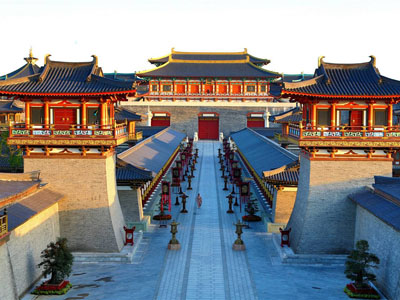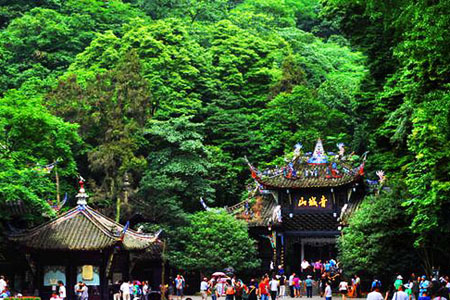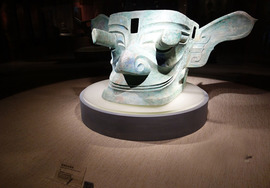
More Information of Sanxingdui Site:
The History of Sanxingdui Excavations:
The discovery of the Sanxingdui ruin site began when a jade stone vessel was accidentally discovered by a local farmer in 1929. In the spring of 1931, when Dong Du, a British missionary in Guanghan County, heard the news, he approached the local army, asked them to help publicize the protection and investigation, and handed the collected jade tools to the West China University Museum run by Americans for safekeeping. According to the clues provided by Dong Du, Ge Weihan, director of the Museum of West China University, and his assistant Lin Mingjun formed an archaeological team in the spring of 1934, chaired by Luo Yicang, head of Guanghan County, and conducted a ten-day excavation near the jade stone ware. The excavation harvest is rich, according to these materials, Ge Weihan compiled the "Hanzhong Excavation Brief". Unfortunately, the excavation of the Sanxingdui site has been stalled for a long time since it was first excavated in 1934.
Since the 1950s, Chinese archaeologists have resumed their archaeological work in Sanxingdui. At that time, they did not realize the size of the Sanxingdui site, so they took the Moon Bay site in the north and the Sanxingdui site in the south as one site, named "Liangzi Site" and "Sanxingdui Site" respectively. In 1963, a joint archaeological team led by Feng Hanji and the Sichuan Provincial Museum and the History Department of Sichuan University once again excavated the Moon Bay and other sites of Sanxingdui site, showing the basic appearance of Sanxingdui site and culture. At that time, Professor Feng Hanji had realized that "the ruins around Sanxingdui were so dense that it is likely to be a central capital of the ancient Shu State".
After the 1980s and 1990s, the Sanxingdui ruin site ushered in a period of large-scale continuous excavation for 20 years. During the excavation from 1980 to 1981, pieces of neolithic sites were cleared, tens of thousands of specimens were unearthed, and a hierarchical overlapping relationship was found. The excavation report "guanghan sanxingdui ruins", points out that sanxingdui is "a widely distribution in Sichuan region, has distinct characteristics, is different from any other archaeological culture of a kind of ancient culture", has had the summer light named archaeological culture three conditions, suggested named "sanxingdui culture".
In 1982 and 1984, archaeologists conducted two excavations in the southwest of the Sanxingdui site and the Xiquankan site, and discovered the latest remains of the Sanxingdui site. In 1986, a large number of relics were unearthed in Sanxingdui. According to the excavation materials of this year, some archaeological researchers began to phase the Sanxingdui site. It was also in 1986 that two rectangular artifact pits with rich treasures were accidentally revealed, and the contents of a large number of metal tools were unearthed, which aroused the attention of academic circles at home and abroad to the ancient Shu civilization located in southwest China. At the same time of the large-scale excavation of the Sanxingdui site, the archaeological team excavated the Twelfth Bridge site in downtown Chengdu from 1985 to 1987. The lowest cultural appearance of the bottom level of the site is the same as the latest remains of the site, providing important materials for the whereabouts of the Sanxingdui culture and other issues.
Since 1990, the exploration of Sanxingdui culture and civilization has been extended from Chengdu Plain to eastern Chongqing and southern Shaanxi, which provides a broader prospect for the in-depth research of Sanxingdui civilization.
In February 2022, the State Administration of Cultural Heritage designated the archaeological excavation of the sacrificial area of Sanxingdui Site as one of the implementation contents of the Study on the Civilization Process in Sichuan and Chongqing Region, a major project of "Archaeological China" of the State Administration of Cultural Heritage. Since the excavation started in March 2020, they have initially understood the distribution range and internal pattern of the sacrificial area, and discovered six new "sacrificial pits". Now K3, K4, K5, K6 has finished the field excavation work, K7, K8 excavation work has been more than half. More than 11,000 pieces of numbered cultural relics have been unearthed in the six newly discovered "sacrificial pits", and more than 2,400 pieces of nearly complete ware, including more than 870 pieces of bronze, 510 pieces of gold, more than 450 pieces of jade, more than 120 pieces of stone tools and 13 pieces of pottery, and more than 400 complete ivory have been extracted.
CCTV reported on June 12,2022 that after nearly half a year of excavation, archaeological experts initially confirmed that in addition to the six newly discovered sacrificial pits, there is also an area of more than 80 square meters next to the archaeological greenhouse. The remains of the building appeared as early as the summer of 2020, and it was not until October 2021 that the team officially excavated it. As of June 2022, archaeologists have basically understood the shape of the building, and have called it F1 for short. With the advance of archaeological work, the stone kneeling figures, stone tiger, ivory and jade chisel have been found around the house. Experts judge that there may still be a small sacrificial pit in this area.
On June 13,2022, the press briefing on the archaeological excavation of Sanxingdui ruin held in Guanghan, Sichuan province announced that the archaeological excavation of six newly discovered sacrificial pits at Sanxingdui ruin has entered the final stage. A total of nearly 13,000 numbered cultural relics were unearthed in the six pits, including 3,155 relatively complete cultural relics. Except for pit 5 and pit 6, pit 3,4,7 and 8 sacrificial pits had the same burial time, which was in the late Shang Dynasty. Archaeologists have also discovered small sacrificial pits and building sites in the sacrificial area.
On June 14,2022, the archaeological excavation of pits 7 and 8 of Sanxingdui sacrificial area continued. As early as December 12, the bronze altar of No.8 pit was successfully extracted. In the center of the first platform above the base of the altar, a miniature bronze figure kneels on the raised platform. Lei Xingshan, a professor at the School of Archaeology and Museology of Peking University, said that this little man can be in the center of the altar, when the people are expensive.
On the afternoon of June 14,2022, the "treasure of the town pit" in the No.7 pit of Sanxingdui Site was also extracted.
On June 16,2022, Sanxingdui archaeologists extracted a copper head of a gold mask located in pit 8. Its glittering and golden appearance is very eye-catching. What is precious is the gold mask, which still fits perfectly over the bronze head. It is also the only gold mask still attached to the bronze head in the new archaeological excavation in Sanxingdui.
On June 16,2022, an axe-shaped gold device was found in the No.5 pit of Sanxingdui. The maximum width is about 4.6 cm, its length exceeds 10 cm, and the thickness is at least 3 mm. It is almost the thickest gold device seen in Sanxingdui.
On June 16,2022, the top zun snake figure found in Sanxingdui No.8 pit and the bird's foot figure unearthed in No.2 pit more than 30 years ago.
By September 2022, a total of 15,109 numbered cultural relics and 4,060 nearly complete pieces had been unearthed in six "sacrificial pits" newly discovered at the Sanxingdui site.
The historical value of Sanxingdui
Historians previously believed that the birthplace of the Chinese nation was the Yellow River basin, and then gradually spread to the whole of China. The discovery of Sanxingdui pushed the history of the ancient Shu State forward to 5,000 years ago, proving that the Yangtze River basin is the birthplace of the Chinese nation like the Yellow River basin, and proving that the ancient civilization in the Yangtze River basin existed no less than that in the Yellow River basin. Because the discovery of Sanxingdui site is quite different from the long-standing historical understanding of Bashu culture, and even completely different in some places. Historians have always believed that, compared with the Central Plains region, the ancient Bashu region was a relatively closed place, with no connection or little communication with the Central Plains civilization. The Sanxingdui site proves that it should be an important cultural center before and after the Xia and Shang dynasties in China, or even earlier, and has a certain connection with the Central Plains culture. The relics of Sanxingdui Site verify the authenticity of the ancient Shu records in ancient documents.
For the bronze vessels unearthed from the two sacrificial pits, except for the bronze vessels of the Yin and Shang culture in the Central Plains and the middle reaches of the Yangtze River, the types and shapes of the other objects have extremely strong local characteristics. The excavation of Sanxingdui cultural relics shows for the first time the highly developed and unique appearance of the Shu bronze civilization in the middle and late Shang Dynasty. In the aspect of bronze smelting, the use of Sanxingdui cultural relics in the fan casting method and separate casting method, and the smelting of ternary alloy mainly with lead, tin and copper, shows that the ancient Shu state of Sanxingdui had a highly developed bronze civilization in the Shang and Zhou dynasties. The Sanxingdui ruin strongly refuted the fallacy of traditional historiography about the lagging culture around the Central Plains. Sanxingdui cultural relics are cultural relics with world influence and belong to the category of world cultural heritage.
Sanxingdui cultural relics fill the important gaps in Chinese archaeology, aesthetics, history and other fields. The Sanxingdui ruins require the world to reevaluate the ancient Chinese civilization. Among the Sanxingdui cultural relics, it is 3.95 meters high, with "Fusang", "Jianmu", "Romu" and other sacred trees. It is divided into three layers, with nine branches, and a bird standing on each branch. It is not a bird in the general sense, but a divine bird representing the sun. Among the cultural relics unearthed in Sanxingdui are the bronze statue, known as the king of bronze statues, and the vertical mask, known as the king of masks, which is considered the idol of the silkworm cong, the ancestors of the Shu people. In addition, Sanxingdui also has a 1.42-meter-long golden rod as a powerful staff, carved with exquisite and mysterious patterns, two opposite birds, two opposite fish, and an arrow on the head of the fish and the neck of the bird, and a human head full of mysterious smiles. The jade bian zhang covered with decorative patterns and dozens of bronze heads of the size of real heads are never seen before.
Cultural relics unearthed from Sanxingdui:
The bronze, jade and gold products unearthed from the Sanxingdui site are peculiar in shape and beautifully made. Sanxingdui cultural relics all show a strong and mysterious religious culture color, but also unique national characteristics and regional characteristics, is an extremely rare human ancient history and treasures. Sanxingdui cultural relics enjoy a very high reputation in the world.
As of 2009, Sanxingdui has created and broken many world records and Chinese records, many of which have been selected by the Chinese World Records Association in the world and the most in China.
The earliest and highest bronze sacred tree in the world. At 384 cm high, three clusters of branches, each cluster of three branches, a total of nine branches. There are 27 fruit nine birds, the side of the tree has a dragon edge tree meandering down. May be inferred for the ancient myth of the mulberry tree.
The earliest golden rod in the world. It is 142 cm long, 2.3 cm in diameter, and weighs more than 700 grams. There are carved head head, fish and bird decoration.
The largest and most complete bronze statue in the world. With a height of 262 centimeters and weighing more than 180 kilograms, he is called the king of bronze statues.
The world's largest bronze longitudinal portrait.64.5 cm high and 138.5 cm apart.
The world's most once unearthed bronze heads, masks. There are more than 50 pieces.
From July to September 1986, two large Shang Dynasty sacrificial pits unearthed nearly 1,000 precious cultural relics such as gold, copper, jade, stone, pottery, shellfish and bone. Among the thousands of bronze, gold and jade wares unearthed from the Sanxingdui sacrificial pit, the most distinctive ones are the first 300 to 400 bronze wares
Types of bronze ware unearthed in Sanxingdui No.1 pit, human face, human masks, kneeling figures, dragon ornaments, dragon pillar, tiger, tiger, ring, qi square hole, dragon and tiger, sheep, pulle, cover, plate, etc. The gold rod from the No.1 sacrificial pit, is 1.42 meters in length with a diameter of 2.3 centimeters in foil, wrapped on a wooden pole, with a net weight of about 500 grams.
The bronze ware unearthed in Sanxingdui No.2 pit include large bronze portrait, kneeling figure, human head, human mask, animal mask, animal face, animal face, sacred altar, sacred tree, sun shape, eye shape, eye bubble, copper bell, bronze pendant, bronze square hole bi, bird, bird, snake, chicken, monster, buffalo head, deer, catfish and so on. The bronze statue unearthed from the No.2 sacrificial pit is 180 cm high and 260.8 cm high. It is the earliest and largest bronze unearthed in the world. The bronze sacred tree is 350 centimeters high, and is hung with many birds, animals, bells and various fruits, which is a special artifact for ancient wizards. In addition, more than 40 kinds of bronze heads and more than 10 masks were unearthed. The discovery of these unprecedented precious cultural relics in Sanxingdui pushed forward the civilization history of the ancient Shu state for 1500 years, which caused a sensation in the world archaeology circle.
The pottery unearthed from the Sanxingdui site is composed of high-handled beans, small flat jars and bird-shaped spoons. There is also a bottle-shaped cup, which is a ware with great local characteristics unearthed from Sanxingdui. It is made into a trumpet, fine neck, round and flat, much like the ceramic wine bottles used to hot wine in northern China, and the Japanese drink sake wine bottle is very similar. Tao also has more found in the site, quite characteristic, generally three 40 centimeters, the lower part of the three pocket foot, the middle is empty, can increase the capacity, generally believe that it is used to warm wine utensils. Sanxingdui jade stone tools to the day, zhang for more. Known as the "king of Bian zhang" jade edge zhang, its residual length of 159 cm, 1.8 cm thick, 22 cm wide, its processing is exquisite, angular, its body engraved with grain. Such a large and exquisite jade article is the only one found in the existing archaeological discoveries in China.
More than 80 pieces of ivory were unearthed in two sacrificial pits in Sanxingdui. There are many views of their origin and function in the academic circle: some believe that they come through trade, and some believe that the ecological environment in ancient Sichuan is suitable for the survival of elephants. The evidence is mainly a large number of semi-fossil ebony found in the local area, with huge monomer. But whatever its source, it can be considered as a symbol of the ruler's wealth.
The bronzes unearthed in Sanxingdui have bronze heads of different shapes. When unearthed, the face is painted, and the earlobes were pierced to hang earrings, it seems that our ancestors love beauty very much. In addition to these bronze statues, there are many statues used for sacrifice, including various forms of animal and plant shapes, including the bronze chicken, known as the masterpiece of realism, and the bronze sun ware unearthed for the first time in China. They are all significantly different from the Central Plains culture, which shows that Sanxingdui culture is not only a typical representative of the ancient Shu culture, but also an ancient civilization center in the upper reaches of the Yangtze River, thus eloquproving again that the origin of Chinese civilization is diverse and integrated.
The latest excavation progress of Sanxingdui:
On May 28,2021, the Sichuan Provincial Institute of Cultural Relics and Archaeology announced that six new "sacrificial pits" were discovered in Sanxingdui, and six new "sacrificial pits" were discovered in Sanxingdui. They have recently unearthed more than 1,000 pieces of important cultural relics, such as silk, elaborate ivory carvings and mysterious wooden boxes coated with cinnabar.
On September 9,2021, major archaeological achievements were rediscovered in pit 3 and pit 4 in the sacrificial area of Sanxingdui Site. The jade cong found in no. 3 pit is made of a whole piece of gray and white jade material, corresponding to the carved sacred tree lines with very shallow marks. The jade cong with the pattern of the sacred tree has never been seen before, which provides an important basis for the study of the meaning and symbol of the sacred tree in the ancient Shu society.
The newly discovered bronze altar in the No.8 pit of Sanxingdui is huge and peculiar in shape. We can clearly see that the altar is divided into three parts: platform, portrait, and god beast. The platform is divided into three layers, gradually shrinking. The first layer is plain surface, the second layer is shallow relief decoration, and the third layer is hollow decoration. Above the platform is a platform, casting three groups of figures. On the bronze altar found this time, many different images seem to describe the roles and behaviors of different personnel in the sacrificial activities at that time, reproducing the scene of the sacrificial activities at that time. These provide very important information for the study of how the sacrificial activities are carried out and how the Sanxingdui sacrificial pit is formed.
Ancient experts also found the remains of the bronze sacred tree in pit 7. When the archaeologists excavated the southern edge of the No.7 pit, they gradually cleared out a remnant of a small sacred tree, with flowers and fruits clearly visible, and a phoenix bird standing on a branch. Experts introduced that the no. 3 small sacred tree unearthed in 1986, the shape of its branches and the size of the flowers and the newly discovered sacred tree remains in no. 7 pit have a high similarity. The no. 3 small sacred tree came to a standstill due to incomplete parts.
A bronze statue of Tiger head and Dragon Body
According to the news on January 31,2022, Sanxingdui has a new discovery: No.8 "sacrificial pit" found a bronze tiger head and dragon body "god beast", head with two horns, gold bottom tiger tattoo beast body, half dragon and half tiger, strange shape.... It is a dragon, but it looks "tiger", at first glance vivid, very lovely. Zhao Hao, an associate professor at the School of Archaeology and Museology of Peking University, in charge of the no. 8 "sacrificial pit", said the newly discovered object was temporarily named " a bronze statue with a tiger-headed dragon body.
A total of six bronze sacred trees were excavated at the Sanxingdui ruin, the most complete of which is the "No.1 sacred tree" unearthed in the second sacrificial pit in 1986.3.96 meters high, it is the largest single bronze relic in China. It was just unearthed when the broken, a total of 2,479 pieces of debris.
Pig nose with Drgon body tap cylinder
On August 4,2022, a pig nose faucet pillar was extracted from the pit in the sacrificial area of the Sanxingdui ruin. The device is 1.2 meters long, 38 centimeters high, head wide (between the eyes) 20 centimeters, and 12 centimeters wide in body. The whole piece is a four-minute symmetrical form, with the head and body have its own seams. The whole object is a long column, the faucet has a wide nose, a long ear, a single horn in the middle, the body is evenly distributed with scales and a series of feather-like patterns.
Bronze birds with hollow wings
Sanxingdui archaeological site found a winged "four-winged small god beast", this is the first winged god beast found in Sanxingdui. Pit 8 also shows a bronze bird with hollow wings, which is the only bronze bird found in Sanxingdui.
When archaeologists cleaned a bronze "hollow animal cover" in Sanxingdui 8 pit, they found its very interesting details: a small bronze man the size of his palm, close to the hollow pattern, his hands struggling to support the edge of the cover. His calves, toes and arms are full, and his hollow patterns lift a platform. On the platform stands a small god beast, which is significantly different from the four-legged god beast unearthed in Sanxingdui before.
An important relic of Sanxingdui Ruin
The west city wall Ruin
The west wall is located on the high platform between Duck River and Mamu River in the northwest of Sanxingdui Site, running from northeast to southwest. The existing part of the ground is about 600 meters long, the top width is about 10~30 meters, the bottom width is about 35~50 meters and about 3~6 meters high. In the middle and north of the wall, there is a gap of about 20 meters wide, and the west wall is divided into north, middle and south sections. The southern end of the middle section turns east at the gap for about 40 meters, which is slightly vertical with the north section of the middle section. According to the local trial excavation, combined with the analysis of the profile of the wall and the contents of the rammed earth and the northern duck River and the southern Mu River, the structure, volume, compaction method and age of the west wall are similar to those of the south wall and the east wall.
Moon Bay City Wall
The Moon Bay wall is located at the eastern edge of the Moon Bay platform in the north of the Sanxingdui ruins, which can be divided into two sections according to the direction. The north section is northeast-southwest, the southern section slightly east, basically north-south. The whole wall is basically parallel to the northern section of the west wall. The existing part of the wall floor is about 650 meters long, about 20 meters wide and 2.4~5 meters high. The bottom width of the north end is about 30~45 meters, the middle part is folded, the Angle is 148 degrees, the north end is 32 degrees, and the southern end is north-south. The southern section of the city wall is higher and is leveled by farming, with a width of 80 meters. There are trenches on the east (outer) side of the wall, with a width of 40~55 meters. At the excavated section, the trench is 3.5 meters deep from the surface, and the mouth of the trench is 2.95 meters deep from the bottom of the ditch.
Sacrifice pit
The famous Sanxingdui No.1 and No.2 sacrificial pits are located more than 50 meters southeast of the city wall of Sanxingdui, 25 meters apart, which is one of the most important archaeological discoveries at the Sanxingdui site. The two pits have the same direction, both are northeast —— southwest direction, the pit mouth is rectangular, the mouth is large and small bottom, the pit wall is neat, and the filling soil is rammed.
Sanxingdui City Wall
According to the foundation of the wall, the wall of Sanxingdui is 260 meters long and the foundation is 42 meters wide. There is a trench on the south side of the wall, with a width of 30~35 meters. The trench is 2.84 meters deep from the surface and 2.4 meters deep. There are two gaps on the city wall, forming "three piles", the gap is not earlier than the Ming Dynasty. Therefore, Sanxingdui is an inner city wall. Some scholars describe Sanxingdui as an altar, or directly describe Sanxingdui as an earth altar, which should be corrected.
The city wall is located in the south of Sanxingdui Site, leading from northwest to southeast. The northwest part of the northwest is about 40 meters long, and the southeast end is only a little rammed earth near the edge of the bank. The distribution of the original city wall is basically faintly visible. According to the anatomical and investigation data, the remaining part of Sanxingdui city wall is about 6 meters high, with a top width of 5~7 meters wide and a bottom width of 40~45 meters wide. The structure, construction method, volume and contents of the wall are basically the same as the east, west and south walls, but the width of the top is less than that of other walls.
Recommended Sanxingdui Ruin Tours:
1. 1 Day Mysterious Sanxingdui and Giant Panda Tour
2. 2 Days Panda, Sanxingdui and Qingchengshan Tours
3. Oriental Eden Exploration

 Guanghan City, Sichuan Province. It is a huge site group composed of the distribution points of many ancient cultural relics. Sanxingdui covers an area of 12 square kilometers and has a history of 3,000 to 5,000 years ago. Sanxingdui is the ancient city, ancient country and ancient Shu culture site with the largest range, the longest duration and the richest cultural connotation found in Southwest China. Sanxingdui has the most complete preserved east, west and south walls and the inner walls of the Moon Bay. The Sanxingdui site is known as one of the greatest archaeological discoveries of the 20th century: Sanxingdui shows that the Yangtze River, like the Yellow River, is the mother of Chinese civilization. Sanxingdui is known as the "source of the Yangtze River civilization". Archaeologists divide the cultural relics of Sanxingdui Site into four periods, and the first phase is the early accumulation, belonging to the late Neolithic culture; the second to the bronze culture. The Sanxingdui Site Group dates from the late Neolithic age to the late Shang Dynasty and the early Zhou Dynasty, and continued for nearly 2,000 years.
Guanghan City, Sichuan Province. It is a huge site group composed of the distribution points of many ancient cultural relics. Sanxingdui covers an area of 12 square kilometers and has a history of 3,000 to 5,000 years ago. Sanxingdui is the ancient city, ancient country and ancient Shu culture site with the largest range, the longest duration and the richest cultural connotation found in Southwest China. Sanxingdui has the most complete preserved east, west and south walls and the inner walls of the Moon Bay. The Sanxingdui site is known as one of the greatest archaeological discoveries of the 20th century: Sanxingdui shows that the Yangtze River, like the Yellow River, is the mother of Chinese civilization. Sanxingdui is known as the "source of the Yangtze River civilization". Archaeologists divide the cultural relics of Sanxingdui Site into four periods, and the first phase is the early accumulation, belonging to the late Neolithic culture; the second to the bronze culture. The Sanxingdui Site Group dates from the late Neolithic age to the late Shang Dynasty and the early Zhou Dynasty, and continued for nearly 2,000 years. The unearthed cultural relics in Sanxingdui are a valuable cultural heritage of mankind. Among the cultural relics groups in China, Sanxingdui is one of the most historical, scientific, cultural, artistic value and the most ornamental cultural relics groups. In this batch of ancient Shu secret treasures, there are 2.62 meters high, bronze masks 1.38 meters wide, and 3.95 meters high, which can be called unique treasures. And the gold ware represented by the golden staff, and the jade stone ware represented by the edge of the decorative pattern are also mostly rare treasures not seen before. On March 20,2021, an archaeological team unearthed more than 500 important cultural relics in six newly discovered "sacrificial pits", three of which were found in ivory. On March 21, an ivory weighing more than 50Kg in pit 4 was completely extracted. A large number of important cultural relics were unearthed from the Sanxingdui "sacrificial pit", as well as the intact east, west and south walls and the inner wall of the Moon Bay. The excavated Sanxingdui area is only about 2 percent of the total area of the site.
The unearthed cultural relics in Sanxingdui are a valuable cultural heritage of mankind. Among the cultural relics groups in China, Sanxingdui is one of the most historical, scientific, cultural, artistic value and the most ornamental cultural relics groups. In this batch of ancient Shu secret treasures, there are 2.62 meters high, bronze masks 1.38 meters wide, and 3.95 meters high, which can be called unique treasures. And the gold ware represented by the golden staff, and the jade stone ware represented by the edge of the decorative pattern are also mostly rare treasures not seen before. On March 20,2021, an archaeological team unearthed more than 500 important cultural relics in six newly discovered "sacrificial pits", three of which were found in ivory. On March 21, an ivory weighing more than 50Kg in pit 4 was completely extracted. A large number of important cultural relics were unearthed from the Sanxingdui "sacrificial pit", as well as the intact east, west and south walls and the inner wall of the Moon Bay. The excavated Sanxingdui area is only about 2 percent of the total area of the site. flame is peculiar. Sanxingdui ruin site is an important representative of the world bronze civilization from the 16th century BC to the 14th century BC. It is of great value to the study of the process of early countries and the development of religious consciousness. Sanxingdui occupies an important position in the development history of human civilization. Sanxingdui is the largest capital site in southwest China. Its discovery provided a unique material evidence for the disappearing ancient Shu State, and pushed forward the civilization history of Sichuan region for more than 2,000 years.
flame is peculiar. Sanxingdui ruin site is an important representative of the world bronze civilization from the 16th century BC to the 14th century BC. It is of great value to the study of the process of early countries and the development of religious consciousness. Sanxingdui occupies an important position in the development history of human civilization. Sanxingdui is the largest capital site in southwest China. Its discovery provided a unique material evidence for the disappearing ancient Shu State, and pushed forward the civilization history of Sichuan region for more than 2,000 years.






